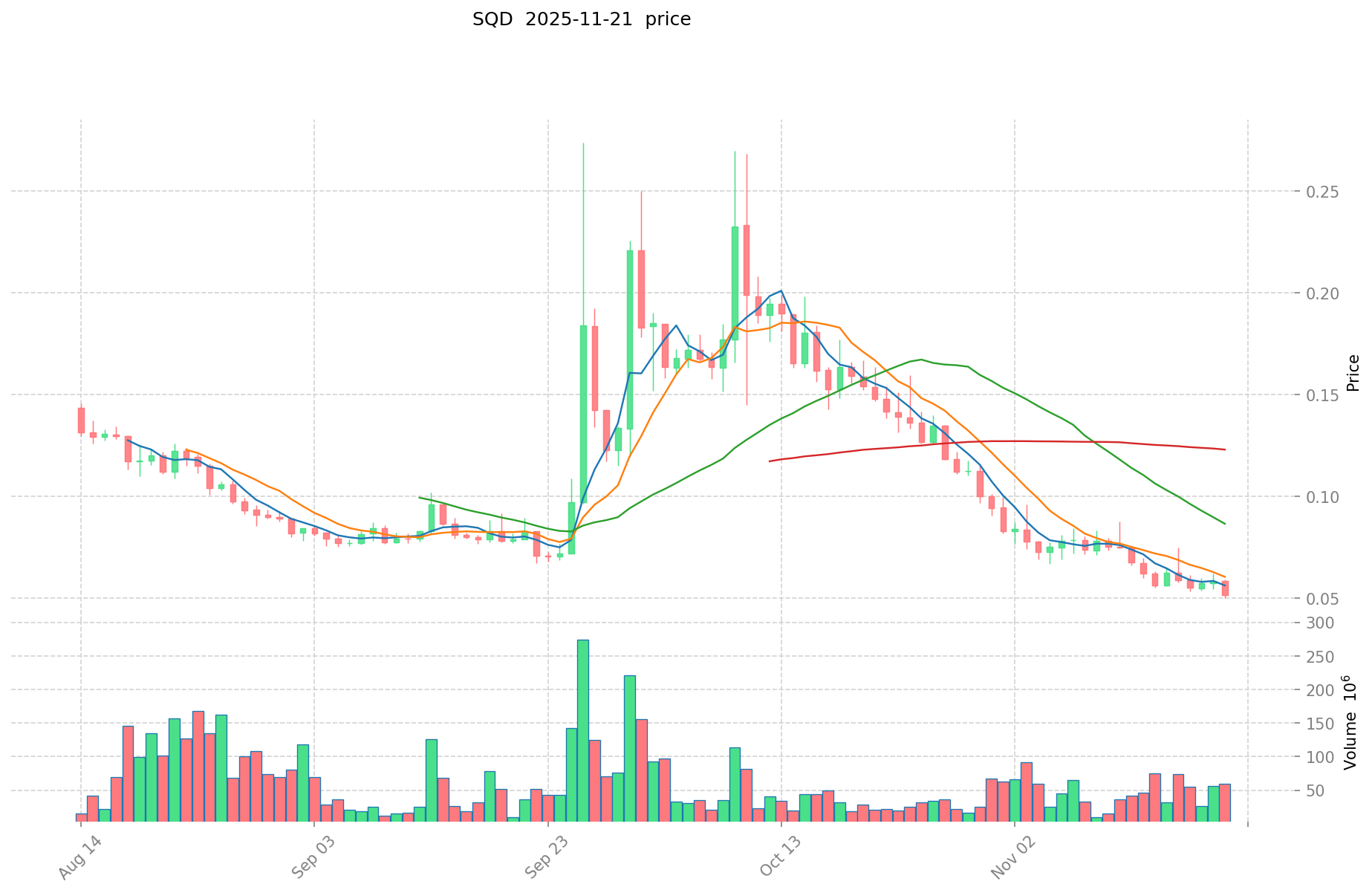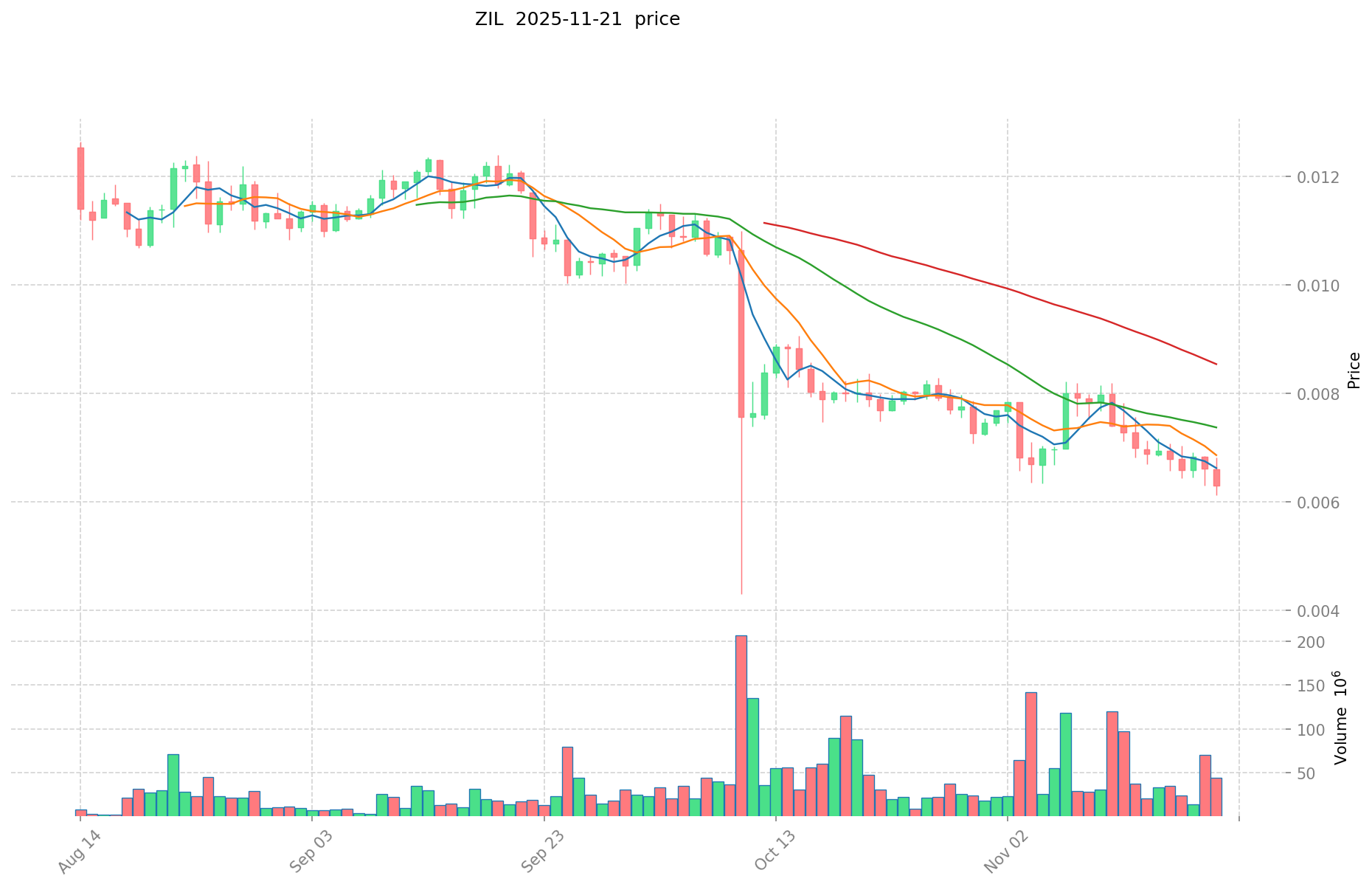SQD vs ZIL: A Comparative Analysis of Two Emerging Cryptocurrencies
Introduction: Investment Comparison of SQD vs ZIL
In the cryptocurrency market, the comparison between Subsquid (SQD) vs Zilliqa (ZIL) has always been a topic that investors cannot avoid. The two not only show significant differences in market cap ranking, application scenarios, and price performance, but also represent different positioning in crypto assets.
Subsquid (SQD): Since its launch, it has gained market recognition for its hyper-scalable data access layer that powers dApps.
Zilliqa (ZIL): Since its inception in 2018, it has been hailed as a high-throughput public blockchain platform, aiming to solve transaction speed and scalability issues.
This article will comprehensively analyze the investment value comparison between SQD and ZIL, focusing on historical price trends, supply mechanisms, institutional adoption, technical ecosystems, and future predictions, attempting to answer the question that concerns investors the most:
"Which is the better buy right now?"
I. Price History Comparison and Current Market Status
SQD and ZIL Historical Price Trends
- 2024: SQD reached its all-time high of $0.5 on May 17, 2024.
- 2020: ZIL hit its all-time low of $0.00239616 on March 13, 2020.
- Comparative analysis: SQD has shown significant volatility, reaching a low of $0.02288 on November 16, 2024, while ZIL's all-time high of $0.255376 was achieved on May 7, 2021.
Current Market Situation (2025-11-21)
- SQD current price: $0.04977
- ZIL current price: $0.005842
- 24-hour trading volume: SQD $4,795,912.89 vs ZIL $516,284.20
- Market Sentiment Index (Fear & Greed Index): 14 (Extreme Fear)
Click to view real-time prices:
- Check SQD current price Market Price
- Check ZIL current price Market Price


II. Core Factors Affecting the Investment Value of SQD vs ZIL
Supply Mechanisms Comparison (Tokenomics)
- SQD: Limited supply with a total cap of 1 billion tokens, distributed across ecosystem building, team allocation, and community rewards
- ZIL: Fixed maximum supply of 21 billion tokens with a deflationary mechanism through transaction fee burning
- 📌 Historical Pattern: Deflationary mechanisms like ZIL's fee burning have historically supported price stability during market downturns, while SQD's limited supply model may create scarcity-driven value appreciation during demand surges.
Institutional Adoption and Market Applications
- Institutional Holdings: ZIL has gained more institutional interest with listings on major exchanges like Binance, Coinbase and Huobi, while SQD is still establishing its institutional presence
- Enterprise Adoption: ZIL shows stronger enterprise integration through its sharding technology enabling scalable business applications, while SQD focuses on specialized gaming and metaverse applications
- Regulatory Attitudes: Both tokens face varying regulatory frameworks across jurisdictions, with ZIL's longer market presence providing more regulatory clarity compared to SQD
Technical Development and Ecosystem Building
- SQD Technical Upgrades: Focus on cross-chain operability and gaming platform integration with emphasis on metaverse applications
- ZIL Technical Development: Sharding technology implementation for scalability, Scilla smart contract language for enhanced security, and Zilliqa 2.0 upgrade focusing on EVM compatibility
- Ecosystem Comparison: ZIL has a more mature ecosystem spanning DeFi applications, NFT marketplaces, and payment solutions, while SQD is building a specialized ecosystem centered around gaming and metaverse applications
Macroeconomic Factors and Market Cycles
- Inflation Performance: ZIL has demonstrated more resilience during inflationary periods due to its established market presence and deflationary mechanism
- Monetary Policy Impacts: Both tokens show negative correlation with interest rate hikes, with ZIL historically demonstrating more stability during Federal Reserve policy shifts
- Geopolitical Factors: ZIL's wider global distribution and adoption provides better insulation against regional regulatory shocks compared to SQD's more concentrated market presence
III. 2025-2030 Price Prediction: SQD vs ZIL
Short-term Prediction (2025)
- SQD: Conservative $0.0379-$0.0499 | Optimistic $0.0499-$0.0638
- ZIL: Conservative $0.0047-$0.0058 | Optimistic $0.0058-$0.0084
Mid-term Prediction (2027)
- SQD may enter a growth phase, with expected prices $0.0503-$0.0671
- ZIL may enter a steady growth phase, with expected prices $0.0056-$0.0086
- Key drivers: Institutional capital inflow, ETF, ecosystem development
Long-term Prediction (2030)
- SQD: Base scenario $0.0556-$0.0794 | Optimistic scenario $0.0794-$0.0968
- ZIL: Base scenario $0.0059-$0.0115 | Optimistic scenario $0.0115-$0.0134
Disclaimer: This analysis is based on historical data and current market trends. Cryptocurrency markets are highly volatile and unpredictable. This information should not be considered as financial advice. Always conduct your own research before making investment decisions.
SQD:
| 年份 | 预测最高价 | 预测平均价格 | 预测最低价 | 涨跌幅 |
|---|---|---|---|---|
| 2025 | 0.0638336 | 0.04987 | 0.0379012 | 0 |
| 2026 | 0.072201786 | 0.0568518 | 0.035816634 | 14 |
| 2027 | 0.06710786472 | 0.064526793 | 0.05033089854 | 29 |
| 2028 | 0.0704245418802 | 0.06581732886 | 0.0408067438932 | 32 |
| 2029 | 0.090600844042233 | 0.0681209353701 | 0.053134329588678 | 36 |
| 2030 | 0.096820285441523 | 0.079360889706166 | 0.055552622794316 | 59 |
ZIL:
| 年份 | 预测最高价 | 预测平均价格 | 预测最低价 | 涨跌幅 |
|---|---|---|---|---|
| 2025 | 0.00839664 | 0.005831 | 0.00472311 | 0 |
| 2026 | 0.0073272346 | 0.00711382 | 0.0038414628 | 21 |
| 2027 | 0.008592427487 | 0.0072205273 | 0.005559806021 | 23 |
| 2028 | 0.01075280925516 | 0.0079064773935 | 0.006720505784475 | 35 |
| 2029 | 0.013621279253521 | 0.00932964332433 | 0.00876986472487 | 59 |
| 2030 | 0.013426289708043 | 0.011475461288925 | 0.005852485257352 | 96 |
IV. Investment Strategy Comparison: SQD vs ZIL
Long-term vs Short-term Investment Strategies
- SQD: Suitable for investors focused on gaming and metaverse potential
- ZIL: Suitable for investors seeking established ecosystems and scalability solutions
Risk Management and Asset Allocation
- Conservative investors: SQD: 30% vs ZIL: 70%
- Aggressive investors: SQD: 60% vs ZIL: 40%
- Hedging tools: Stablecoin allocation, options, cross-token portfolios
V. Potential Risk Comparison
Market Risks
- SQD: Higher volatility due to newer market presence and specialized focus
- ZIL: Potential market saturation in the scalability solutions space
Technical Risks
- SQD: Scalability, network stability
- ZIL: Hash power concentration, security vulnerabilities
Regulatory Risks
- Global regulatory policies may impact both differently, with ZIL potentially facing less uncertainty due to its longer market presence
VI. Conclusion: Which Is the Better Buy?
📌 Investment Value Summary:
- SQD advantages: Specialized focus on gaming and metaverse, potential for rapid growth in niche markets
- ZIL advantages: Established ecosystem, proven scalability technology, wider institutional adoption
✅ Investment Advice:
- New investors: Consider a higher allocation to ZIL for its established presence and lower volatility
- Experienced investors: Balanced approach with both tokens, leveraging SQD's growth potential and ZIL's stability
- Institutional investors: Focus on ZIL for its broader ecosystem and regulatory clarity, with a smaller allocation to SQD for exposure to emerging tech trends
⚠️ Risk Warning: The cryptocurrency market is highly volatile. This article does not constitute investment advice. None
VII. FAQ
Q1: What are the main differences between SQD and ZIL? A: SQD focuses on gaming and metaverse applications with a limited token supply, while ZIL is a more established blockchain platform with sharding technology and a deflationary mechanism. ZIL has a broader ecosystem and more institutional adoption, whereas SQD is newer with potential for rapid growth in niche markets.
Q2: Which token has shown better price performance historically? A: ZIL has shown more price stability and a longer track record, reaching its all-time high of $0.255376 in May 2021. SQD, being newer, has shown higher volatility, with its all-time high of $0.5 in May 2024, but also experienced significant lows.
Q3: How do the supply mechanisms of SQD and ZIL differ? A: SQD has a limited supply of 1 billion tokens, distributed across ecosystem building, team allocation, and community rewards. ZIL has a fixed maximum supply of 21 billion tokens with a deflationary mechanism through transaction fee burning.
Q4: Which token is more suitable for long-term investment? A: For long-term investment, ZIL may be more suitable for investors seeking established ecosystems and scalability solutions. SQD might be more appropriate for those focusing on gaming and metaverse potential, though it comes with higher volatility.
Q5: What are the predicted price ranges for SQD and ZIL in 2030? A: For SQD, the base scenario predicts $0.0556-$0.0794, with an optimistic scenario of $0.0794-$0.0968. For ZIL, the base scenario predicts $0.0059-$0.0115, with an optimistic scenario of $0.0115-$0.0134.
Q6: How should investors allocate their assets between SQD and ZIL? A: Conservative investors might consider allocating 30% to SQD and 70% to ZIL, while aggressive investors might opt for 60% SQD and 40% ZIL. The allocation should be based on individual risk tolerance and investment goals.
Q7: What are the main risks associated with investing in SQD and ZIL? A: For SQD, main risks include higher volatility, scalability issues, and network stability. For ZIL, risks involve potential market saturation in scalability solutions, hash power concentration, and security vulnerabilities. Both face regulatory risks, though ZIL may have less uncertainty due to its longer market presence.
Share
Content